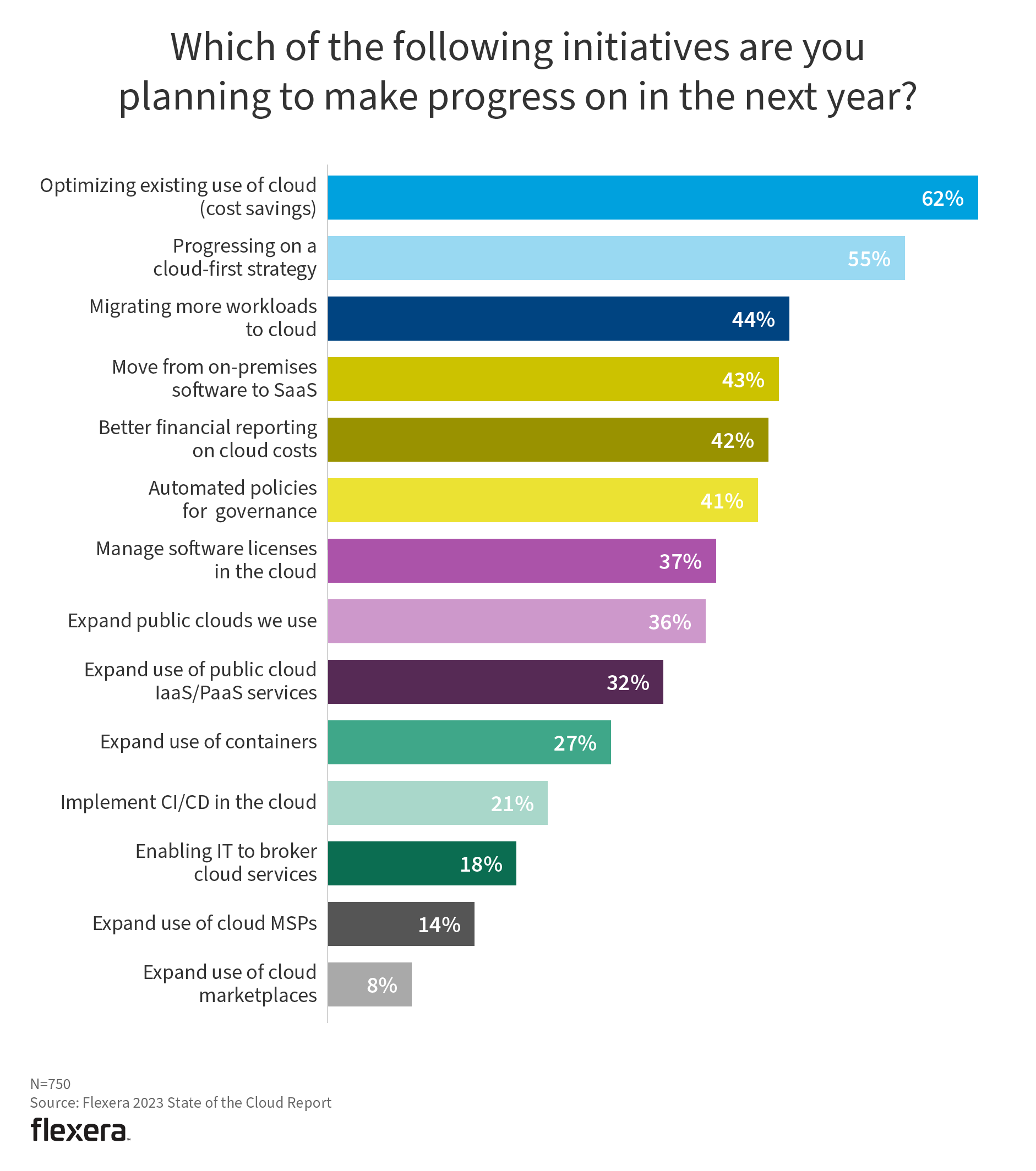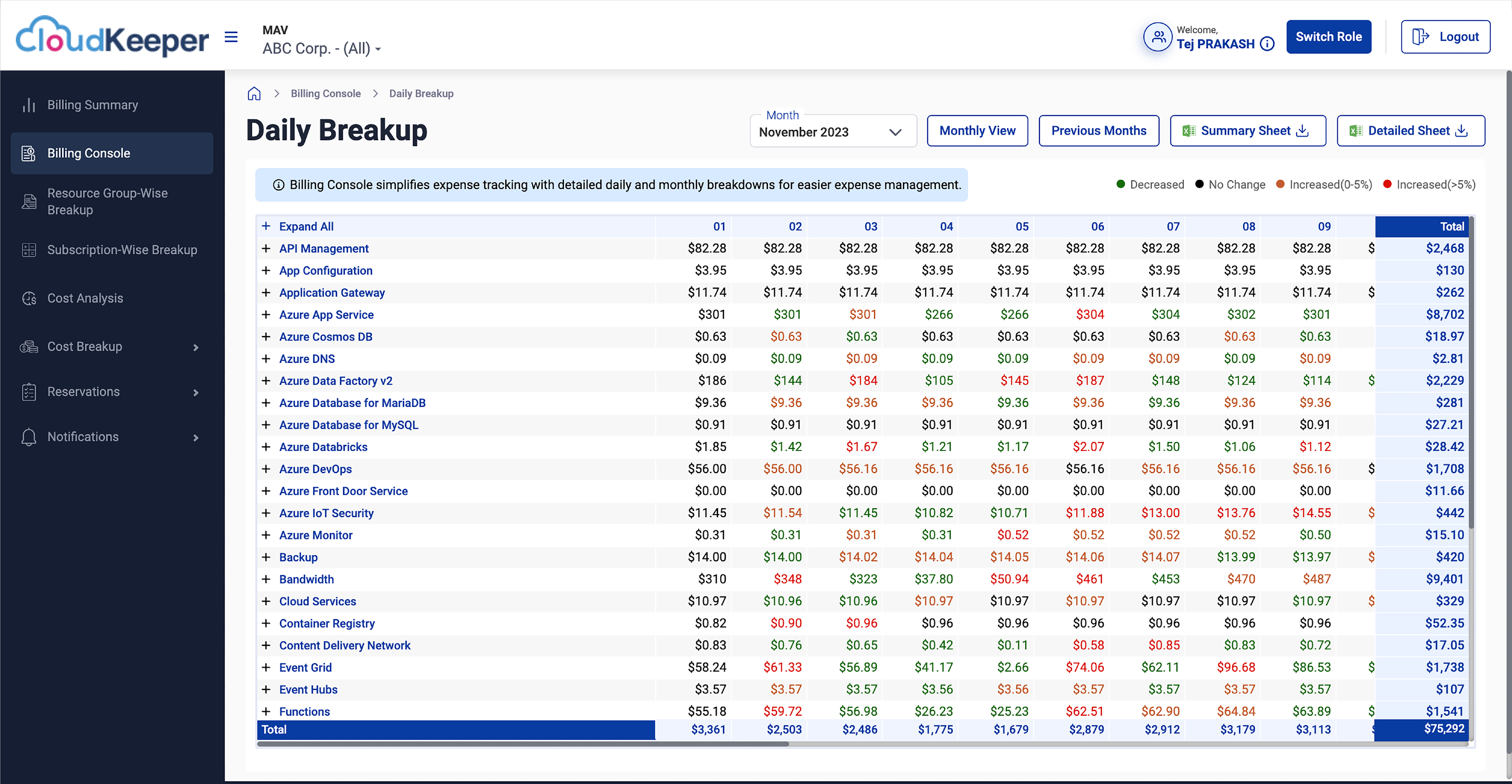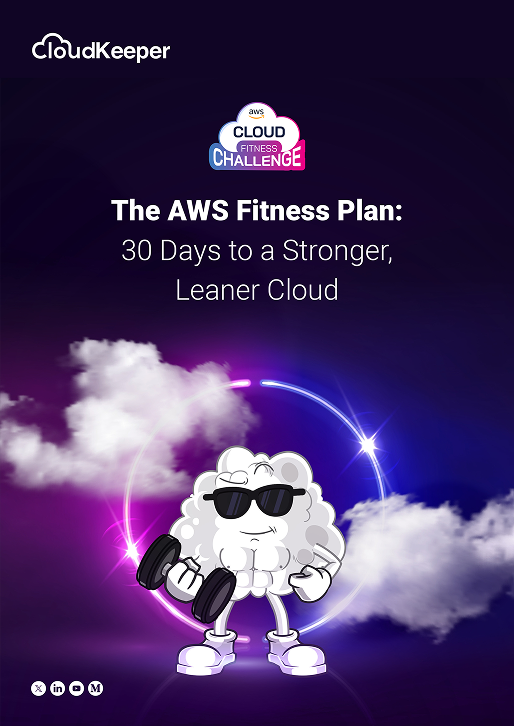Imagine a scenario where your cloud expenses are not a burden but a strategic asset, where every dollar spent fuels innovation and growth. Cloud cost optimization is the key to unlocking this reality, transforming cloud spending from a source of anxiety into a driver of long-term business success.
As organizations increasingly embrace the cloud for its agility, scalability, and cost-efficiency, they find themselves facing a paradox: while the cloud offers immense potential for savings, it also harbors hidden costs that can quickly spiral out of control if left unmonitored. Moreover, research reveals that a whopping 32% of cloud spend gets wasted by organizations.
Together, let’s dive into detail about cloud cost optimization, the strategies, and best practices to get really good at managing cloud costs.
What is Cloud Cost Optimization?
Cloud cost optimization is an ongoing and strategic process to manage and control the expenses of cloud computing services while maintaining optimal performance and efficiency. This intricate process goes beyond mere cost-cutting or reduction and encompasses a comprehensive set of cloud cost optimization techniques, measures, tools, and best practices.
At its core, cloud cost optimization involves:
- Right-sizing your cloud computing resources.
- Identifying inefficiencies and optimizing resource allocation.
- Eliminating waste/unnecessary cloud expenditure.
- Leveraging discounts provided by cloud providers to acquire more resources cost-effectively.
- Gaining better cloud visibility with the help of cloud cost management tools.

There's a common misconception that merely reducing cloud expenses equals optimization. In reality, the ultimate objective of cloud cost optimization is to utilize resources efficiently, striking a balance between cost, performance, security, and availability. This, in turn, supports funding for growth-oriented initiatives for organizations, like rolling out improved feature updates.
Why is cloud cost optimization a non-negotiable for your business?
Did you know that cloud cost optimization is the top cloud initiative for the seventh year running?
 For businesses, opting out of cloud cost optimization doesn't hold water when you weigh the numerous compelling reasons to embrace it. It offers multifaceted benefits that significantly enhance your cloud experience. Let's delve into these advantages for a clearer picture.
For businesses, opting out of cloud cost optimization doesn't hold water when you weigh the numerous compelling reasons to embrace it. It offers multifaceted benefits that significantly enhance your cloud experience. Let's delve into these advantages for a clearer picture.

Financial Benefits of Cloud Cost Optimization
Cloud Cost Reduction
Cost optimization in the cloud acts as a guiding light for organizations, offering strategies such as right-sizing resources, auto-scaling, automation, and leveraging reserved instances to minimize expenses associated with cloud services.
Cloud Budget Predictability
Cloud cost optimization empowers better budget planning by providing a deep understanding of cloud expenses, cloud usage, and trends. Platforms like CloudKeeper Lens, are great saviors in such scenarios. This ensures that organizations are well-prepared and prevent unexpected financial surprises while allowing for better budget planning.

Cost Governance and Accountability
Cloud cost governance and accountability are crucial parts of cloud cost optimization. This enables creating a structure, defining budgets and allocation policies, employing cost management tools, assigning cost ownership, and efficient management, monitoring, and transparency of cloud expenses.
Cost-Conscious Culture
Cloud cost optimization involves fostering an organizational mindset where every team member, from developers to operations, is aware of and considers the financial implications of their decisions. In a cost-conscious culture, everyone collaboratively works towards optimizing expenses and ensuring financial sustainability.
Actionable Advice: Empower your team with the knowledge and skills necessary for making cost-effective decisions. Provide training on cloud pricing models, proficient use of cloud cost optimization tools, and best practices.
Performance Benefits of Cloud Cost Optimization
Optimum Cloud Resource Utilization
Cloud cost optimization makes sure you use cloud resources just right by adjusting them to match what you actually need. The strategies like automation and load balancing help distribute resources efficiently as the workload changes.
Data-driven Decision Making
Cloud cost optimization thrives on data-driven insights. By monitoring and analyzing cloud expenditures, businesses can gain valuable insights into cloud cost patterns, usage trends, and potential areas for cloud spend optimization. Armed with these insights, organizations can make informed decisions to optimize cloud spend, directly impacting profit margins positively.
Picture a scenario where a business had to decide whether to invest in scaling up infrastructure or optimizing existing cloud resources. Cloud cost optimization data guides them to make the right decision.
Scalability and Flexibility
Cloud cost optimization contributes significantly to scalability and flexibility by allowing businesses to align their resource allocation with actual demand, thereby enhancing operational efficiency and cloud cost-effectiveness.
Imagine an e-commerce giant like Amazon, whose online sales surge during the holiday season. Their cloud infrastructure, the backbone of their operations, must scale up rapidly to accommodate the influx of customers. However, maintaining that peak capacity throughout the year leads to exorbitant costs.
Through cloud cost optimization they can dynamically scale up their resources to handle the increased demand, ensuring smooth operations and customer satisfaction. Importantly, during less busy times, they can scale down to avoid overpaying for resources they don't need, demonstrating the flexibility and cost-efficiency that cloud cost optimization provides.
Better Cloud Performance
Inefficient resource allocation often leads to slow application performance. Through cloud cost optimization, the business not only saved costs but also improved the overall user experience, enhancing customer satisfaction.
Competitive Advantage
Cloud cost optimization provides a competitive advantage by directing funds strategically toward innovation, customer experience, or other growth areas.
Let’s take the example of two businesses in the same industry—one investing in cloud cost optimization and the other overspending on unused resources. The former had the financial flexibility to invest in new technologies and customer-focused initiatives, gaining a competitive edge in the market.
Cloud Cost Optimization Best Practices
Below are some must-do cloud cost optimization best practices that every organization should prioritize:
1. Gain insights into your cloud usage
The foundation of cloud cost optimization lies in gaining a comprehensive understanding of an organization's usage patterns and seasonal fluctuations. It also makes forecasting cloud spend optimization becomes a more manageable task.
An effective strategy involves employing cloud cost optimization tools that provide an exhaustive overview of existing cloud usage and expenses and enhance the visualization and analytical aspects of monitoring.
2. Comprehend your cloud bill
Make sure you understand your cloud bill beyond just the total amount. Effective cloud cost optimization necessitates a deeper understanding of the bill's components and overall cloud pricing structure. This helps you figure out where your money is going and make informed decisions to reduce cloud costs effectively.
Actionable Advice: Joining forces with a cloud cost optimization partner like CloudKeeper eases the task of understanding your usage patterns and managing your bill. This collaboration not only brings peace of mind but also unlocks tailored benefits like personalized recommendations, enhancing your overall cloud efficiency.
3. Right-Size your cloud resources
Right-sizing refers to tailoring your cloud computing resources to match the workload requirements, ensuring that you have neither too little nor too much capacity. By right-sizing, organizations can optimize performance, enhance reliability, reduce overhead costs, and improve the overall end-user experience.
Below are some proactive strategies for right-sizing:
a. Performance Monitoring: Implementing robust performance monitoring tools and techniques allows businesses to gain real-time insights into their computing infrastructure. By analyzing usage patterns, peak loads, and resource demands, organizations can proactively identify bottlenecks and make informed decisions about rightsizing.
b. Capacity Planning: Businesses must go beyond mere reactive resource management and engage in proactive capacity planning. By forecasting future demands, businesses can efficiently align their resource provisioning strategies with expected workload growth.
c. Automated Resource Scaling: Leveraging automation, businesses can dynamically scale their resources based on actual demand. This proactive approach enables efficient utilization of resources during peak periods while scaling down during periods of lower demand, leading to cloud cost savings and improved performance.
d. Load Balancing: Distributing workloads across multiple resources can help optimize utilization and prevent overutilization of specific resources. This strategy enhances performance, prevents downtime, and ensures high availability, making rightsizing more effective.
e. Continuous Evaluation and Optimization: Rightsizing is not a one-time process; it requires ongoing evaluation and optimization. By regularly assessing their computing resources against actual requirements, organizations can remain agile and responsive to changing business needs.
Actionable Advice: Leverage heatmaps to understand peak usage times and periods of underutilization. This helps you make informed decisions about establishing start and stop times to save and reduce cloud costs.

4. Monitor and Correct cloud cost anomalies
Establishing a strong monitoring system that goes beyond conventional dashboards and manual analytics is crucial for effective cloud cost optimization. Cloud cost optimization tools can further enhance an organization's ability to detect and act on cloud cost anomalies.
Once anomalies are detected, the next crucial step is correcting them promptly.
Additionally, implementing automated cost control measures, such as setting spending limits, budgets and alters, tagging or utilizing instance scheduling, can help prevent future anomalies from occurring.
5. Identify Unused and Unattached Cloud Resources
As cloud systems get bigger and more complicated, there's a higher chance of having resources that are not being used, unattached, or just sitting idle. Implementing best practices such as regular resource audits, tagging mechanisms, and established governance policies can contribute to proactive resource management and cloud cost optimization.
6. Focus on Cloud Storage Optimization
Cloud storage offers a variety of options, each tailored to specific data types and usage patterns. Selecting the most appropriate storage solution that aligns with your data's performance needs and access frequency is crucial to optimize performance and reduce cloud costs.
Actionable Advice: Schedule regular storage audits to identify and remove outdated or unused data, including obsolete backups, or old data that no longer serve any business purpose.
7. Limit Data Transfer charges
Reduce expenses associated with data transfer charges by minimizing the exchange of data between various regions or services.
8. Opt for Reserved Instances and Spot Instances
Reserved Instances offer businesses the opportunity to maximize cost savings by providing significant discounts on computing resources compared to on-demand Instances. This makes Reserved Instances an ideal choice for workloads with consistent demand or steady-state applications.
On the other hand, Spot Instances offers an innovative way to dramatically cut cloud computing costs by allowing organizations to bid on surplus EC2 capacity. While Spot Instances may not provide guaranteed availability, they offer significant discounts of up to 90% compared to On-Demand Instances.
Actionable Advice: If you would like to enjoy the flexibility of on-demand EC2 & RDS instances at AWS Reserved Instances pricing, all without any commitments or lock-ins explore CloudKeeper Auto.
9. Opt for Enterprise Discounts
By opting for an enterprise discount for example AWS Enterprise Discount Program, businesses can achieve substantial cost optimization. These discounts typically offer tiered pricing models or volume discounts, enabling organizations to enjoy substantial savings as they scale up their cloud requirements.
Actionable Advice: You can unlock the maximum potential of AWS EDP by availing additional discounts, lower annual commitments, and discounted prices on AWS support only with CloudKeeper EDP+.
Let’s optimize tomorrow's cloud costs today
As we conclude, let's remember cloud cost optimization is not a mere checklist; it's a mindset, a personalized journey for each company. Just as a skilled chess player carefully evaluates and strategizes their every move, cloud cost optimization demands a similar approach. It's about making informed decisions that align with your organization's goals, not just about cutting costs blindly.
It's a collective responsibility, involving not just IT but the entire organization. Embracing the cloud cost optimization best practices, keep playing the game wisely, make strategic moves, and see your cloud journey be both efficient and cost-effective. Happy cloud cost optimization!
Would you like an extended team to take up your burden of Cloud Cost Optimization at zero cost?
Well, it is the real deal! Imagine saving not just money but time, resources, and energy too. This is where CloudKeeper comes in.
Trusted by 300+ global businesses CloudKeeper, is a multi-cloud cost optimization partner that provides you with instant and guaranteed savings, a cloud cost visibility platform, and end-to-end FinOps Support - the complete package to ace your cloud cost optimization journey at no cost from your pocket.
ISG Research also affirms that CloudKeeper has proven capabilities and scale in providing FinOps solutions using a combination of platform and cloud cost optimization services.
Intrigued to discover more? Book a free demo today!
